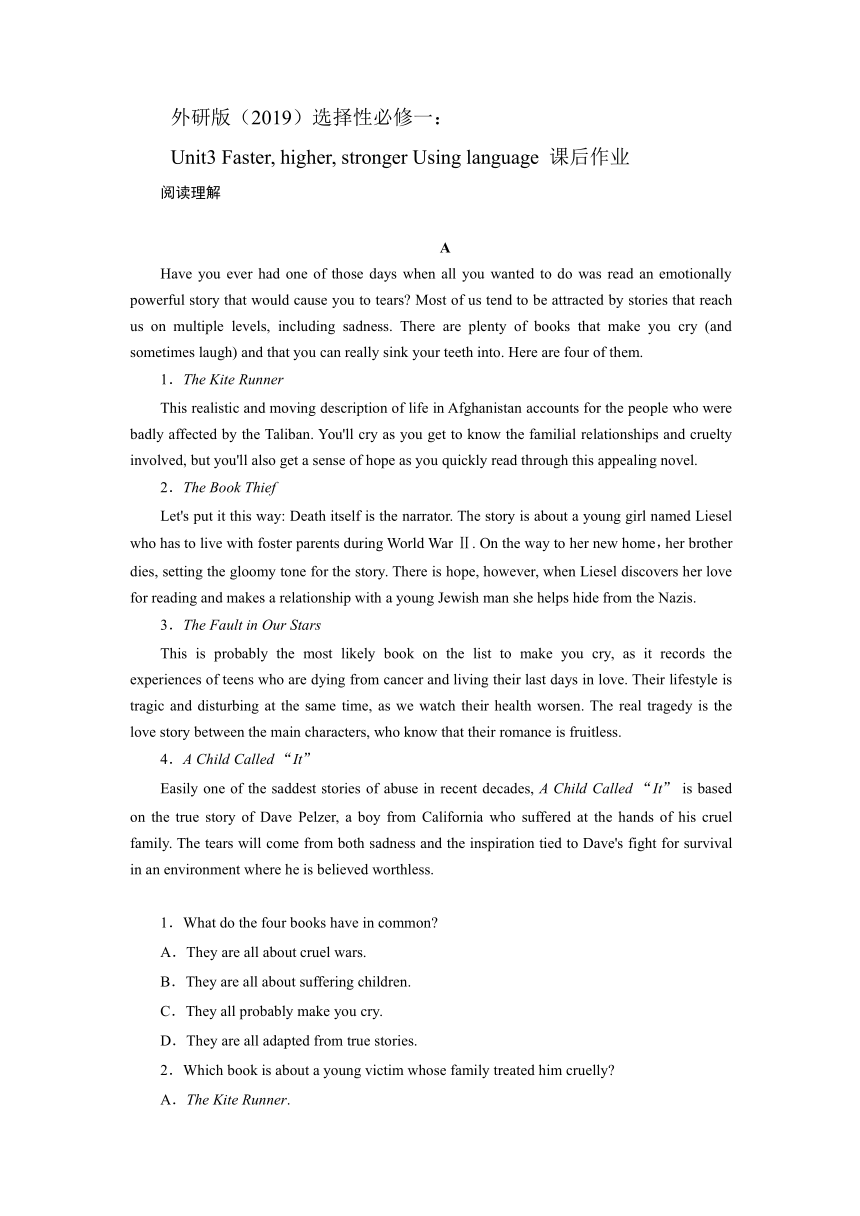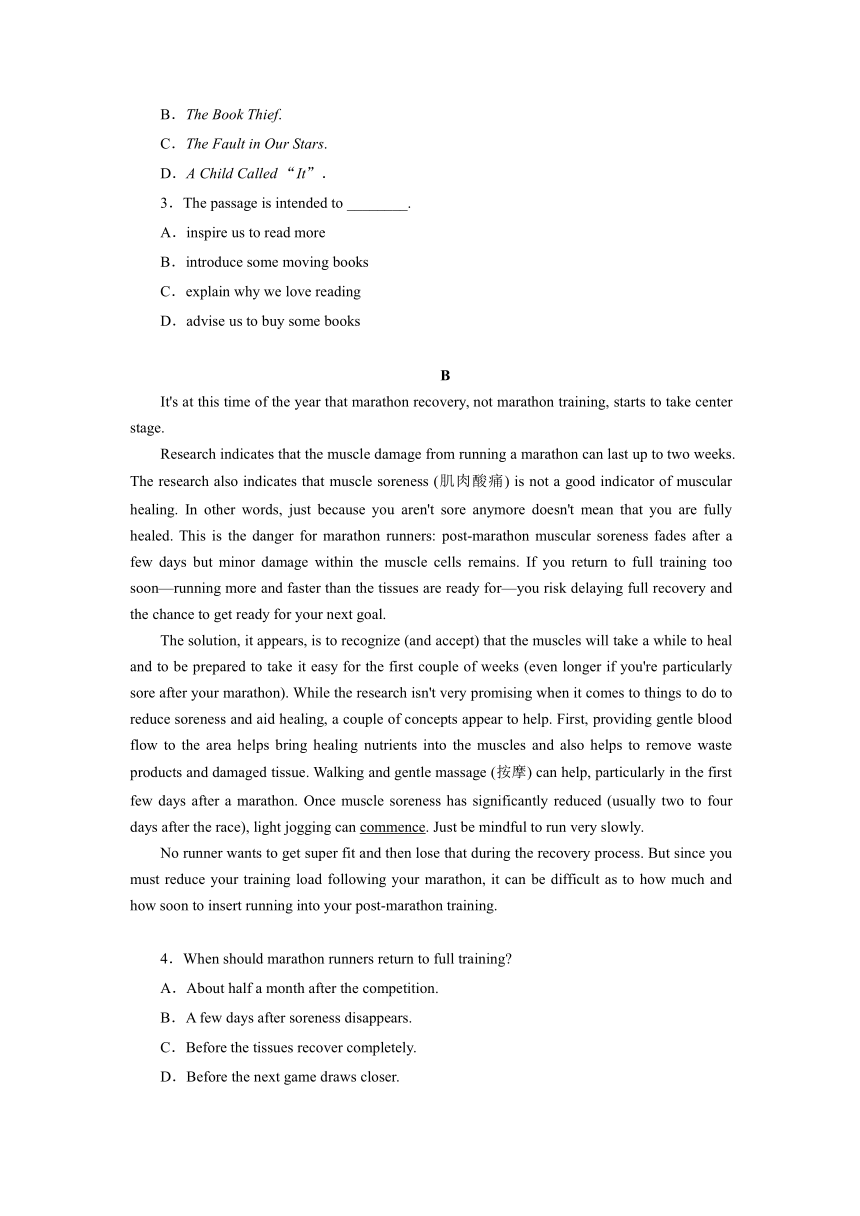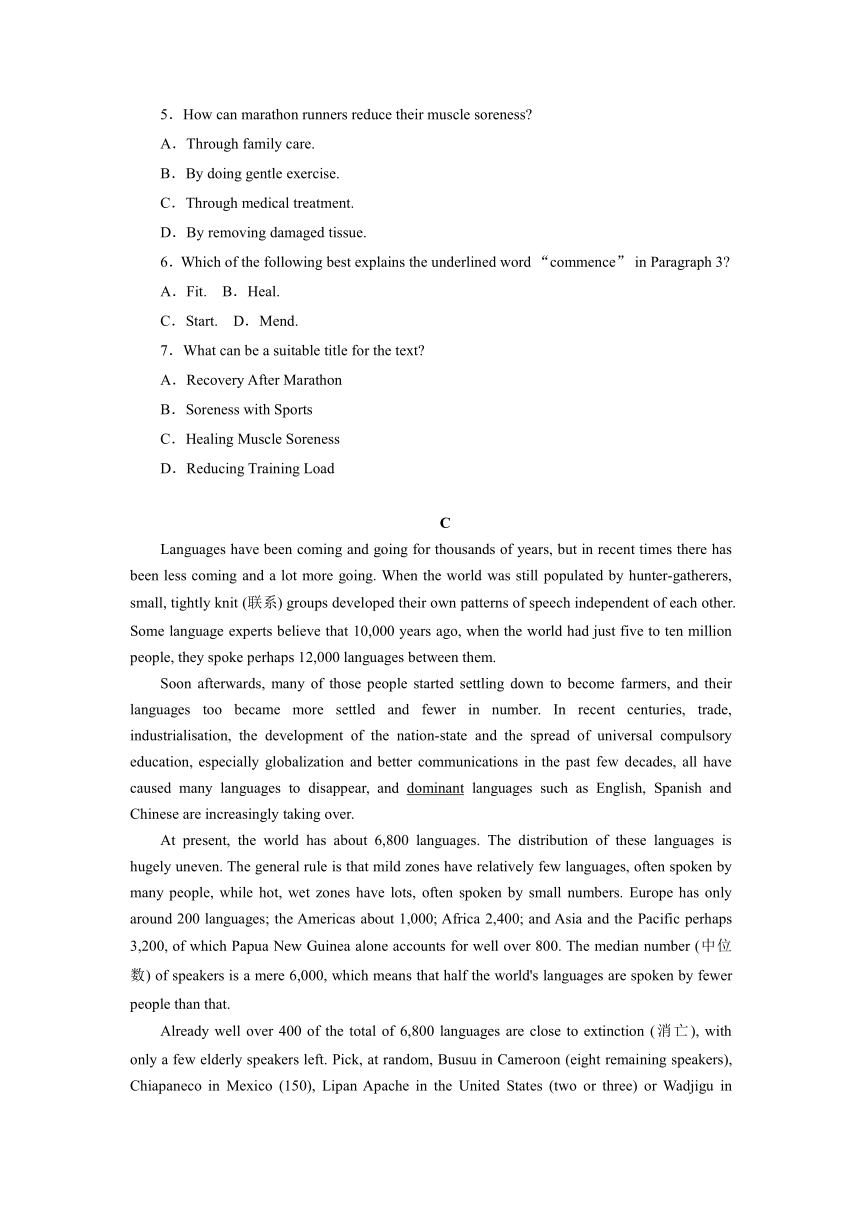外研版(2019)选择性必修一:Unit3 Faster, higher, stronger Using language 课后作业(含答案)
文档属性
| 名称 | 外研版(2019)选择性必修一:Unit3 Faster, higher, stronger Using language 课后作业(含答案) |

|
|
| 格式 | doc | ||
| 文件大小 | 49.0KB | ||
| 资源类型 | 教案 | ||
| 版本资源 | 外研版(2019) | ||
| 科目 | 英语 | ||
| 更新时间 | 2021-09-06 15:32:10 | ||
图片预览



文档简介
外研版(2019)选择性必修一:
Unit3
Faster,
higher,
stronger
Using
language
课后作业
阅读理解
A
Have
you
ever
had
one
of
those
days
when
all
you
wanted
to
do
was
read
an
emotionally
powerful
story
that
would
cause
you
to
tears?
Most
of
us
tend
to
be
attracted
by
stories
that
reach
us
on
multiple
levels,
including
sadness.
There
are
plenty
of
books
that
make
you
cry
(and
sometimes
laugh)
and
that
you
can
really
sink
your
teeth
into.
Here
are
four
of
them.
1.The
Kite
Runner
This
realistic
and
moving
description
of
life
in
Afghanistan
accounts
for
the
people
who
were
badly
affected
by
the
Taliban.
You'll
cry
as
you
get
to
know
the
familial
relationships
and
cruelty
involved,
but
you'll
also
get
a
sense
of
hope
as
you
quickly
read
through
this
appealing
novel.
2.The
Book
Thief
Let's
put
it
this
way:
Death
itself
is
the
narrator.
The
story
is
about
a
young
girl
named
Liesel
who
has
to
live
with
foster
parents
during
World
War
Ⅱ.
On
the
way
to
her
new
home,her
brother
dies,
setting
the
gloomy
tone
for
the
story.
There
is
hope,
however,
when
Liesel
discovers
her
love
for
reading
and
makes
a
relationship
with
a
young
Jewish
man
she
helps
hide
from
the
Nazis.
3.The
Fault
in
Our
Stars
This
is
probably
the
most
likely
book
on
the
list
to
make
you
cry,
as
it
records
the
experiences
of
teens
who
are
dying
from
cancer
and
living
their
last
days
in
love.
Their
lifestyle
is
tragic
and
disturbing
at
the
same
time,
as
we
watch
their
health
worsen.
The
real
tragedy
is
the
love
story
between
the
main
characters,
who
know
that
their
romance
is
fruitless.
4.A
Child
Called
“It”
Easily
one
of
the
saddest
stories
of
abuse
in
recent
decades,
A
Child
Called
“It”
is
based
on
the
true
story
of
Dave
Pelzer,
a
boy
from
California
who
suffered
at
the
hands
of
his
cruel
family.
The
tears
will
come
from
both
sadness
and
the
inspiration
tied
to
Dave's
fight
for
survival
in
an
environment
where
he
is
believed
worthless.
1.What
do
the
four
books
have
in
common?
A.They
are
all
about
cruel
wars.
B.They
are
all
about
suffering
children.
C.They
all
probably
make
you
cry.
D.They
are
all
adapted
from
true
stories.
2.Which
book
is
about
a
young
victim
whose
family
treated
him
cruelly?
A.The
Kite
Runner.
B.The
Book
Thief.
C.The
Fault
in
Our
Stars.
D.A
Child
Called
“It”.
3.The
passage
is
intended
to
________.
A.inspire
us
to
read
more
B.introduce
some
moving
books
C.explain
why
we
love
reading
D.advise
us
to
buy
some
books
B
It's
at
this
time
of
the
year
that
marathon
recovery,
not
marathon
training,
starts
to
take
center
stage.
Research
indicates
that
the
muscle
damage
from
running
a
marathon
can
last
up
to
two
weeks.
The
research
also
indicates
that
muscle
soreness
(肌肉酸痛)
is
not
a
good
indicator
of
muscular
healing.
In
other
words,
just
because
you
aren't
sore
anymore
doesn't
mean
that
you
are
fully
healed.
This
is
the
danger
for
marathon
runners:
post?marathon
muscular
soreness
fades
after
a
few
days
but
minor
damage
within
the
muscle
cells
remains.
If
you
return
to
full
training
too
soon—running
more
and
faster
than
the
tissues
are
ready
for—you
risk
delaying
full
recovery
and
the
chance
to
get
ready
for
your
next
goal.
The
solution,
it
appears,
is
to
recognize
(and
accept)
that
the
muscles
will
take
a
while
to
heal
and
to
be
prepared
to
take
it
easy
for
the
first
couple
of
weeks
(even
longer
if
you're
particularly
sore
after
your
marathon).
While
the
research
isn't
very
promising
when
it
comes
to
things
to
do
to
reduce
soreness
and
aid
healing,
a
couple
of
concepts
appear
to
help.
First,
providing
gentle
blood
flow
to
the
area
helps
bring
healing
nutrients
into
the
muscles
and
also
helps
to
remove
waste
products
and
damaged
tissue.
Walking
and
gentle
massage
(按摩)
can
help,
particularly
in
the
first
few
days
after
a
marathon.
Once
muscle
soreness
has
significantly
reduced
(usually
two
to
four
days
after
the
race),
light
jogging
can
commence.
Just
be
mindful
to
run
very
slowly.
No
runner
wants
to
get
super
fit
and
then
lose
that
during
the
recovery
process.
But
since
you
must
reduce
your
training
load
following
your
marathon,
it
can
be
difficult
as
to
how
much
and
how
soon
to
insert
running
into
your
post?marathon
training.
4.When
should
marathon
runners
return
to
full
training?
A.About
half
a
month
after
the
competition.
B.A
few
days
after
soreness
disappears.
C.Before
the
tissues
recover
completely.
D.Before
the
next
game
draws
closer.
5.How
can
marathon
runners
reduce
their
muscle
soreness?
A.Through
family
care.
B.By
doing
gentle
exercise.
C.Through
medical
treatment.
D.By
removing
damaged
tissue.
6.Which
of
the
following
best
explains
the
underlined
word
“commence”
in
Paragraph
3?
A.Fit.
B.Heal.
C.Start.
D.Mend.
7.What
can
be
a
suitable
title
for
the
text?
A.Recovery
After
Marathon
B.Soreness
with
Sports
C.Healing
Muscle
Soreness
D.Reducing
Training
Load
C
Languages
have
been
coming
and
going
for
thousands
of
years,
but
in
recent
times
there
has
been
less
coming
and
a
lot
more
going.
When
the
world
was
still
populated
by
hunter?gatherers,
small,
tightly
knit
(联系)
groups
developed
their
own
patterns
of
speech
independent
of
each
other.
Some
language
experts
believe
that
10,000
years
ago,
when
the
world
had
just
five
to
ten
million
people,
they
spoke
perhaps
12,000
languages
between
them.
Soon
afterwards,
many
of
those
people
started
settling
down
to
become
farmers,
and
their
languages
too
became
more
settled
and
fewer
in
number.
In
recent
centuries,
trade,
industrialisation,
the
development
of
the
nation?state
and
the
spread
of
universal
compulsory
education,
especially
globalization
and
better
communications
in
the
past
few
decades,
all
have
caused
many
languages
to
disappear,
and
dominant
languages
such
as
English,
Spanish
and
Chinese
are
increasingly
taking
over.
At
present,
the
world
has
about
6,800
languages.
The
distribution
of
these
languages
is
hugely
uneven.
The
general
rule
is
that
mild
zones
have
relatively
few
languages,
often
spoken
by
many
people,
while
hot,
wet
zones
have
lots,
often
spoken
by
small
numbers.
Europe
has
only
around
200
languages;
the
Americas
about
1,000;
Africa
2,400;
and
Asia
and
the
Pacific
perhaps
3,200,
of
which
Papua
New
Guinea
alone
accounts
for
well
over
800.
The
median
number
(中位数)
of
speakers
is
a
mere
6,000,
which
means
that
half
the
world's
languages
are
spoken
by
fewer
people
than
that.
Already
well
over
400
of
the
total
of
6,800
languages
are
close
to
extinction
(消亡),
with
only
a
few
elderly
speakers
left.
Pick,
at
random,
Busuu
in
Cameroon
(eight
remaining
speakers),
Chiapaneco
in
Mexico
(150),
Lipan
Apache
in
the
United
States
(two
or
three)
or
Wadjigu
in
Australia
(one,
with
a
question?mark):
none
of
these
seems
to
have
much
chance
of
survival.
8.What
can
we
infer
about
languages
in
hunter?gatherer
times?
A.They
developed
very
fast.
B.They
were
large
in
number.
C.They
had
similar
patterns.
D.They
were
closely
connected.
9.Which
of
the
following
best
explains
“dominant”
underlined
in
Paragraph
2?
A.Complex.
B.Advanced.
C.Powerful.
D.Modern.
10.How
many
languages
are
spoken
by
less
than
6,000
people
at
present?
A.About
6,800.
B.About
3,400.
C.About
2,400.
D.About
1,200.
11.What
is
the
main
idea
of
the
text?
A.New
Languages
Will
Be
Created.
B.People's
Lifestyles
Are
Reflected
in
Languages.
C.Human
Development
Results
in
Fewer
Languages.
D.Geography
Determines
Language
Evolution.
详解答案
阅读理解
A
【语篇解读】 本文是一则广告。文章主要介绍了令人感动的四本书。
1.答案与解析:C 推理判断题。根据第一段倒数第二句“There
are
plenty
of
books
that
make
you
cry
(and
sometimes
laugh)
and
that
you
can
really
sink
your
teeth
into.”可知,本文介绍的四本书都有可能让你感动得热泪盈眶。故选C。
2.答案与解析:D 细节理解题。根据最后一段中的“A
Child
Called
‘It’
is
based
on
the
true
story
of
Dave
Pelzer,
a
boy
from
California
who
suffered
at
the
hands
of
his
cruel
family.”可知,第四本书的主人公Dave被家人残忍地对待。故选D。
3.答案与解析:B 主旨大意题。根据第一段最后两句“There
are
plenty
of
books
that
make
you
cry
(and
sometimes
laugh)
and
that
you
can
really
sink
your
teeth
into.
Here
are
four
of
them.”并结合全文可知,本文主要介绍了令人感动的四本书。故选B。
B
【语篇解读】 本文是一篇说明文。马拉松赛后运动员常会肌肉酸痛。研究表明肌肉不再酸痛不是肌肉治愈的标志,运动员仍需休息几天才能彻底康复。文章就彻底康复提供了两点行之有效的办法。
4.答案与解析:A 推理判断题。题干问的是运动员什么时候可以返回训练。根据第二段第一句“Research
indicates
that
the
muscle
damage
from
running
a
marathon
can
last
up
to
two
weeks.”可知,肌肉伤害可能会持续两周时间。因此,赛后约半个月运动员才能返回训练。故选A。
5.答案与解析:B 推理判断题。题干问的是马拉松运动员如何能减轻肌肉酸痛。根据第三段倒数第三句“Walking
and
gentle
massage
(按摩)can
help,
particularly
in
the
first
few
days
after
a
marathon.”可知,在赛后的几天里散步和轻柔按摩有帮助。因此,轻微锻炼可减轻酸痛。故选B。
6.答案与解析:C 词义猜测题。根据上下文语境可知,一旦肌肉酸痛明显减轻就可以开始慢跑了,记住一定要跑得非常慢。结合选项可知,start意为“开始”,符合题意。故选C。
7.答案与解析:A 标题概括题。题干问的是本文最适合的标题是什么。通读全文可知,本文主要对马拉松后的康复提出了建议。故选A。
C
【语篇解读】 本文是一篇说明文,文章主要介绍了语言的发展过程及现状。
8.答案与解析:B 推理判断题。根据第一段最后一句“Some
language...between
them.”可知,一些语言专家认为,一万年前世界上只有500万到1
000万人,但他们可能说12
000种语言;该题问的是关于狩猎采集时代的语言我们能推断出什么。根据第一段第二句和关键句可知,狩猎采集时期的人口非常少,但人们使用很多种语言。故选B。
9.答案与解析:C 词义猜测题。该题问的是下列哪一项可以最好地解释第二段中的画线词“dominant”。根据画线词所在句的内容可知,许多语言正在消失,而像英语、西班牙语和汉语等重要的语言正在取而代之。因此画线词的词义与C项最为接近。故选C。
10.答案与解析:B 细节理解题。根据第三段第一句可知,“目前世界上大约有6
800种语言”,根据第三段最后一句,可知“说某种语言的人的中位数只有6
000,这意味着世界上有一半的语言其使用人数少于6
000人。”该题问的是目前少于6
000人使用的语言有多少种。根据关键句可知,6
800种语言的一半是3
400种。故选B。
11.答案与解析:C 主旨大意题。该题问的是本篇文章的主旨大意是什么。根据第一段第一句“Languages
have
been
coming
and
going
for
thousands
of
years,
but
in
recent
times
there
has
been
less
coming
and
a
lot
more
going.”,并结合下文内容可知,文章主要介绍了人类的不断发展导致语言种类越来越少。放选C。
Unit3
Faster,
higher,
stronger
Using
language
课后作业
阅读理解
A
Have
you
ever
had
one
of
those
days
when
all
you
wanted
to
do
was
read
an
emotionally
powerful
story
that
would
cause
you
to
tears?
Most
of
us
tend
to
be
attracted
by
stories
that
reach
us
on
multiple
levels,
including
sadness.
There
are
plenty
of
books
that
make
you
cry
(and
sometimes
laugh)
and
that
you
can
really
sink
your
teeth
into.
Here
are
four
of
them.
1.The
Kite
Runner
This
realistic
and
moving
description
of
life
in
Afghanistan
accounts
for
the
people
who
were
badly
affected
by
the
Taliban.
You'll
cry
as
you
get
to
know
the
familial
relationships
and
cruelty
involved,
but
you'll
also
get
a
sense
of
hope
as
you
quickly
read
through
this
appealing
novel.
2.The
Book
Thief
Let's
put
it
this
way:
Death
itself
is
the
narrator.
The
story
is
about
a
young
girl
named
Liesel
who
has
to
live
with
foster
parents
during
World
War
Ⅱ.
On
the
way
to
her
new
home,her
brother
dies,
setting
the
gloomy
tone
for
the
story.
There
is
hope,
however,
when
Liesel
discovers
her
love
for
reading
and
makes
a
relationship
with
a
young
Jewish
man
she
helps
hide
from
the
Nazis.
3.The
Fault
in
Our
Stars
This
is
probably
the
most
likely
book
on
the
list
to
make
you
cry,
as
it
records
the
experiences
of
teens
who
are
dying
from
cancer
and
living
their
last
days
in
love.
Their
lifestyle
is
tragic
and
disturbing
at
the
same
time,
as
we
watch
their
health
worsen.
The
real
tragedy
is
the
love
story
between
the
main
characters,
who
know
that
their
romance
is
fruitless.
4.A
Child
Called
“It”
Easily
one
of
the
saddest
stories
of
abuse
in
recent
decades,
A
Child
Called
“It”
is
based
on
the
true
story
of
Dave
Pelzer,
a
boy
from
California
who
suffered
at
the
hands
of
his
cruel
family.
The
tears
will
come
from
both
sadness
and
the
inspiration
tied
to
Dave's
fight
for
survival
in
an
environment
where
he
is
believed
worthless.
1.What
do
the
four
books
have
in
common?
A.They
are
all
about
cruel
wars.
B.They
are
all
about
suffering
children.
C.They
all
probably
make
you
cry.
D.They
are
all
adapted
from
true
stories.
2.Which
book
is
about
a
young
victim
whose
family
treated
him
cruelly?
A.The
Kite
Runner.
B.The
Book
Thief.
C.The
Fault
in
Our
Stars.
D.A
Child
Called
“It”.
3.The
passage
is
intended
to
________.
A.inspire
us
to
read
more
B.introduce
some
moving
books
C.explain
why
we
love
reading
D.advise
us
to
buy
some
books
B
It's
at
this
time
of
the
year
that
marathon
recovery,
not
marathon
training,
starts
to
take
center
stage.
Research
indicates
that
the
muscle
damage
from
running
a
marathon
can
last
up
to
two
weeks.
The
research
also
indicates
that
muscle
soreness
(肌肉酸痛)
is
not
a
good
indicator
of
muscular
healing.
In
other
words,
just
because
you
aren't
sore
anymore
doesn't
mean
that
you
are
fully
healed.
This
is
the
danger
for
marathon
runners:
post?marathon
muscular
soreness
fades
after
a
few
days
but
minor
damage
within
the
muscle
cells
remains.
If
you
return
to
full
training
too
soon—running
more
and
faster
than
the
tissues
are
ready
for—you
risk
delaying
full
recovery
and
the
chance
to
get
ready
for
your
next
goal.
The
solution,
it
appears,
is
to
recognize
(and
accept)
that
the
muscles
will
take
a
while
to
heal
and
to
be
prepared
to
take
it
easy
for
the
first
couple
of
weeks
(even
longer
if
you're
particularly
sore
after
your
marathon).
While
the
research
isn't
very
promising
when
it
comes
to
things
to
do
to
reduce
soreness
and
aid
healing,
a
couple
of
concepts
appear
to
help.
First,
providing
gentle
blood
flow
to
the
area
helps
bring
healing
nutrients
into
the
muscles
and
also
helps
to
remove
waste
products
and
damaged
tissue.
Walking
and
gentle
massage
(按摩)
can
help,
particularly
in
the
first
few
days
after
a
marathon.
Once
muscle
soreness
has
significantly
reduced
(usually
two
to
four
days
after
the
race),
light
jogging
can
commence.
Just
be
mindful
to
run
very
slowly.
No
runner
wants
to
get
super
fit
and
then
lose
that
during
the
recovery
process.
But
since
you
must
reduce
your
training
load
following
your
marathon,
it
can
be
difficult
as
to
how
much
and
how
soon
to
insert
running
into
your
post?marathon
training.
4.When
should
marathon
runners
return
to
full
training?
A.About
half
a
month
after
the
competition.
B.A
few
days
after
soreness
disappears.
C.Before
the
tissues
recover
completely.
D.Before
the
next
game
draws
closer.
5.How
can
marathon
runners
reduce
their
muscle
soreness?
A.Through
family
care.
B.By
doing
gentle
exercise.
C.Through
medical
treatment.
D.By
removing
damaged
tissue.
6.Which
of
the
following
best
explains
the
underlined
word
“commence”
in
Paragraph
3?
A.Fit.
B.Heal.
C.Start.
D.Mend.
7.What
can
be
a
suitable
title
for
the
text?
A.Recovery
After
Marathon
B.Soreness
with
Sports
C.Healing
Muscle
Soreness
D.Reducing
Training
Load
C
Languages
have
been
coming
and
going
for
thousands
of
years,
but
in
recent
times
there
has
been
less
coming
and
a
lot
more
going.
When
the
world
was
still
populated
by
hunter?gatherers,
small,
tightly
knit
(联系)
groups
developed
their
own
patterns
of
speech
independent
of
each
other.
Some
language
experts
believe
that
10,000
years
ago,
when
the
world
had
just
five
to
ten
million
people,
they
spoke
perhaps
12,000
languages
between
them.
Soon
afterwards,
many
of
those
people
started
settling
down
to
become
farmers,
and
their
languages
too
became
more
settled
and
fewer
in
number.
In
recent
centuries,
trade,
industrialisation,
the
development
of
the
nation?state
and
the
spread
of
universal
compulsory
education,
especially
globalization
and
better
communications
in
the
past
few
decades,
all
have
caused
many
languages
to
disappear,
and
dominant
languages
such
as
English,
Spanish
and
Chinese
are
increasingly
taking
over.
At
present,
the
world
has
about
6,800
languages.
The
distribution
of
these
languages
is
hugely
uneven.
The
general
rule
is
that
mild
zones
have
relatively
few
languages,
often
spoken
by
many
people,
while
hot,
wet
zones
have
lots,
often
spoken
by
small
numbers.
Europe
has
only
around
200
languages;
the
Americas
about
1,000;
Africa
2,400;
and
Asia
and
the
Pacific
perhaps
3,200,
of
which
Papua
New
Guinea
alone
accounts
for
well
over
800.
The
median
number
(中位数)
of
speakers
is
a
mere
6,000,
which
means
that
half
the
world's
languages
are
spoken
by
fewer
people
than
that.
Already
well
over
400
of
the
total
of
6,800
languages
are
close
to
extinction
(消亡),
with
only
a
few
elderly
speakers
left.
Pick,
at
random,
Busuu
in
Cameroon
(eight
remaining
speakers),
Chiapaneco
in
Mexico
(150),
Lipan
Apache
in
the
United
States
(two
or
three)
or
Wadjigu
in
Australia
(one,
with
a
question?mark):
none
of
these
seems
to
have
much
chance
of
survival.
8.What
can
we
infer
about
languages
in
hunter?gatherer
times?
A.They
developed
very
fast.
B.They
were
large
in
number.
C.They
had
similar
patterns.
D.They
were
closely
connected.
9.Which
of
the
following
best
explains
“dominant”
underlined
in
Paragraph
2?
A.Complex.
B.Advanced.
C.Powerful.
D.Modern.
10.How
many
languages
are
spoken
by
less
than
6,000
people
at
present?
A.About
6,800.
B.About
3,400.
C.About
2,400.
D.About
1,200.
11.What
is
the
main
idea
of
the
text?
A.New
Languages
Will
Be
Created.
B.People's
Lifestyles
Are
Reflected
in
Languages.
C.Human
Development
Results
in
Fewer
Languages.
D.Geography
Determines
Language
Evolution.
详解答案
阅读理解
A
【语篇解读】 本文是一则广告。文章主要介绍了令人感动的四本书。
1.答案与解析:C 推理判断题。根据第一段倒数第二句“There
are
plenty
of
books
that
make
you
cry
(and
sometimes
laugh)
and
that
you
can
really
sink
your
teeth
into.”可知,本文介绍的四本书都有可能让你感动得热泪盈眶。故选C。
2.答案与解析:D 细节理解题。根据最后一段中的“A
Child
Called
‘It’
is
based
on
the
true
story
of
Dave
Pelzer,
a
boy
from
California
who
suffered
at
the
hands
of
his
cruel
family.”可知,第四本书的主人公Dave被家人残忍地对待。故选D。
3.答案与解析:B 主旨大意题。根据第一段最后两句“There
are
plenty
of
books
that
make
you
cry
(and
sometimes
laugh)
and
that
you
can
really
sink
your
teeth
into.
Here
are
four
of
them.”并结合全文可知,本文主要介绍了令人感动的四本书。故选B。
B
【语篇解读】 本文是一篇说明文。马拉松赛后运动员常会肌肉酸痛。研究表明肌肉不再酸痛不是肌肉治愈的标志,运动员仍需休息几天才能彻底康复。文章就彻底康复提供了两点行之有效的办法。
4.答案与解析:A 推理判断题。题干问的是运动员什么时候可以返回训练。根据第二段第一句“Research
indicates
that
the
muscle
damage
from
running
a
marathon
can
last
up
to
two
weeks.”可知,肌肉伤害可能会持续两周时间。因此,赛后约半个月运动员才能返回训练。故选A。
5.答案与解析:B 推理判断题。题干问的是马拉松运动员如何能减轻肌肉酸痛。根据第三段倒数第三句“Walking
and
gentle
massage
(按摩)can
help,
particularly
in
the
first
few
days
after
a
marathon.”可知,在赛后的几天里散步和轻柔按摩有帮助。因此,轻微锻炼可减轻酸痛。故选B。
6.答案与解析:C 词义猜测题。根据上下文语境可知,一旦肌肉酸痛明显减轻就可以开始慢跑了,记住一定要跑得非常慢。结合选项可知,start意为“开始”,符合题意。故选C。
7.答案与解析:A 标题概括题。题干问的是本文最适合的标题是什么。通读全文可知,本文主要对马拉松后的康复提出了建议。故选A。
C
【语篇解读】 本文是一篇说明文,文章主要介绍了语言的发展过程及现状。
8.答案与解析:B 推理判断题。根据第一段最后一句“Some
language...between
them.”可知,一些语言专家认为,一万年前世界上只有500万到1
000万人,但他们可能说12
000种语言;该题问的是关于狩猎采集时代的语言我们能推断出什么。根据第一段第二句和关键句可知,狩猎采集时期的人口非常少,但人们使用很多种语言。故选B。
9.答案与解析:C 词义猜测题。该题问的是下列哪一项可以最好地解释第二段中的画线词“dominant”。根据画线词所在句的内容可知,许多语言正在消失,而像英语、西班牙语和汉语等重要的语言正在取而代之。因此画线词的词义与C项最为接近。故选C。
10.答案与解析:B 细节理解题。根据第三段第一句可知,“目前世界上大约有6
800种语言”,根据第三段最后一句,可知“说某种语言的人的中位数只有6
000,这意味着世界上有一半的语言其使用人数少于6
000人。”该题问的是目前少于6
000人使用的语言有多少种。根据关键句可知,6
800种语言的一半是3
400种。故选B。
11.答案与解析:C 主旨大意题。该题问的是本篇文章的主旨大意是什么。根据第一段第一句“Languages
have
been
coming
and
going
for
thousands
of
years,
but
in
recent
times
there
has
been
less
coming
and
a
lot
more
going.”,并结合下文内容可知,文章主要介绍了人类的不断发展导致语言种类越来越少。放选C。
